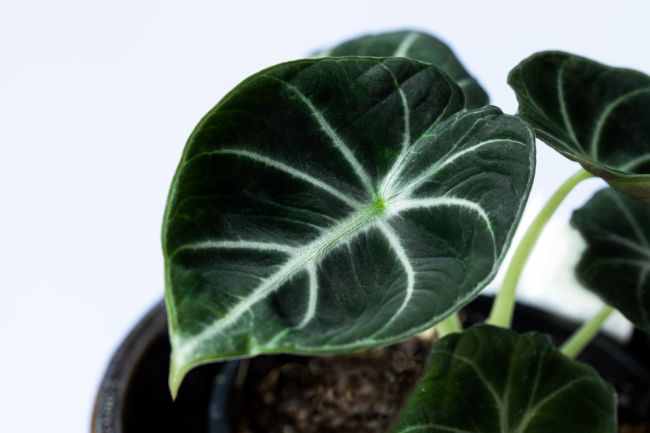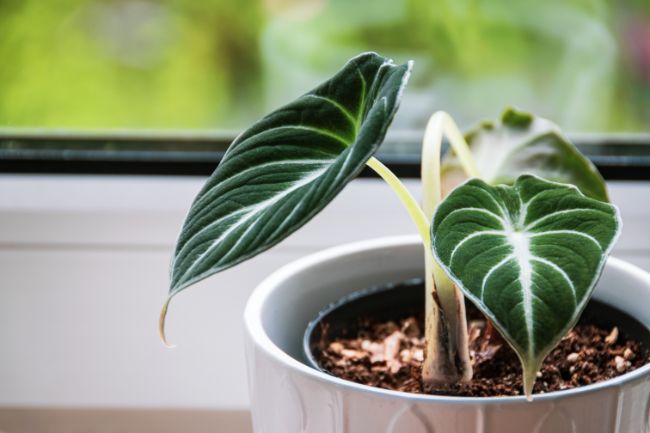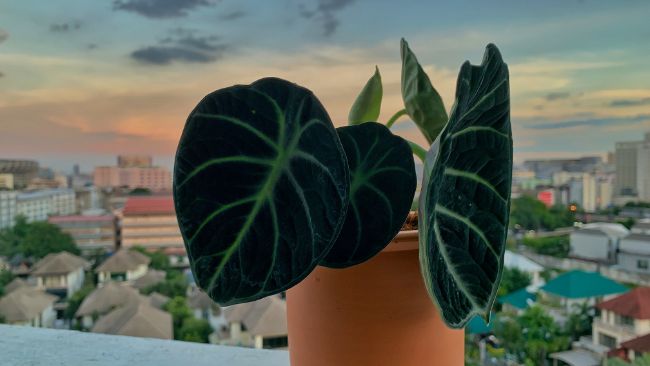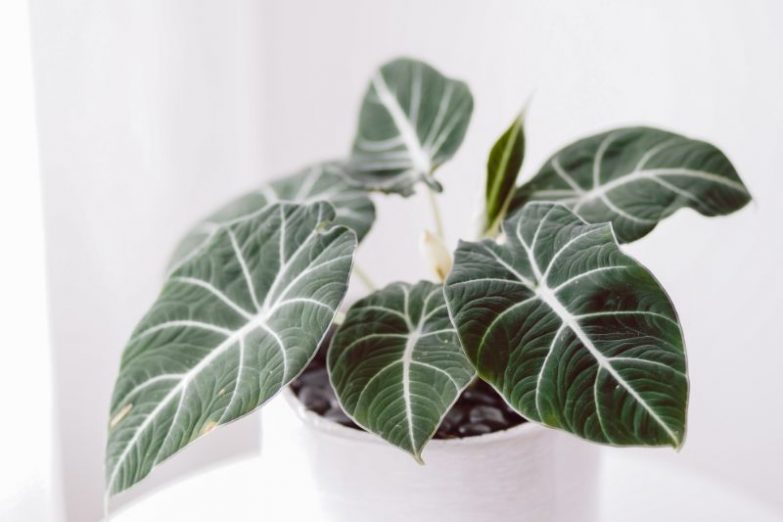The unforgettable Black Velvet Alocasia (Alocasia reginula), or Little Queen, is exotic and elegant, with silver veins that shine against the broad leaf’s dark, velvety background. The plant isn’t demanding so much as it is particular. This article will show you everything you need to know about Alocasia Black Velvet care, to keep yours happy.
Alocasia Black Velvet needs coarse, well-draining soil and careful watering to prevent soggy conditions. It prefers humidity of 60-75%, temperatures of 59-80ºF (15-27ºC), and moderate indirect light. Fertilize lightly every 4 weeks during the growing season and only repot infrequently.
Alocasia Reginula ‘Black Velvet’ Overview
This stunning evergreen perennial of the Araceae family is a native of Southeast Asian jungle floors. Though formerly quite rare, the magic of tissue culture is making the plant more available.
The Black Velvet’s standout feature is dark leaves and prominent pale green, white, or silver veins. Its thick, succulent-like leaves are heart-shaped and have a velvety look and stiff texture. The leaves grow about six inches long and two-and-a-half inches wide.
The strikingly dark leaves developed as a light-gathering strategy in the gloom beneath a forest canopy. The foliage absorbs all visual light waves while their pale veins reflect them.
The Black Velvet is a rhizomatous perennial that stays compact, seldom reaching over eighteen inches high and wide. It goes dormant in cool weather but can stay active year-round with adequate light and warmth.
The plant’s love of humidity makes it an excellent terrarium candidate; despite its diminutive size it, the Black Velvet won’t get lost in a sea of green.
Alocasia Black Velvet Care Summary
| Scientific Name | Alocasia Reginula ‘Black Velvet’ |
| Origin | Borneo |
| Light Requirements | Bright, indirect light. More tolerant of lower light than many other Aroids. |
| Watering | Allow the top two inches of soil to dry before watering. Prone to root rot, so avoid excessively wet conditions or overpotting. |
| Soil | Coarse, free-draining soil. A good mix is two parts each of perlite and orchid bark to one part potting soil. |
| Temperature | 59ºF (15ºC) to 80 (27ºC) or above; they grow faster at the higher end. Won’t tolerate temperatures below 55ºF (13ºC) and dislikes both hot and cold drafts. |
| Fertilizer | Feed monthly with a balanced fertilizer. Apply at half-strength if using an all-purpose preparation. |
| Humidity | A minimum of 40% humidity to prevent foliage problems, but 60% to 75% is the best range. |
| Flowering | Very unlikely to flower indoors. Flowers are unimpressive: a pale yellow spathe surrounding a white spadix spike. |
| Pruning | Minimal pruning required, other than to remove dead leaves. |
| Propagation | By seed, separating offsets, or division of the rhizome. |
| Re-Potting | Does better when slightly rootbound. Avoid repotting more than once every 2-3 years, and only increase pot size slightly. |
| Diseases and Pests | Spider mites are the most likely pests, but reasonably pest-resistant. Fungal leaf spot diseases can be caused by excessive humidity or watering. |
| Toxicity | Contains calcium oxalate crystals which can irritate the mouth and digestive system. It is toxic to humans and pets. |
| Where To Buy | Buy Alocasia Black Velvet online at Etsy (I buy most of my houseplants from Etsy). |

Alocasia Black Velvet Light Requirements
The Black Velvet isn’t as hungry for light as some other aroids, but that doesn’t mean it likes the dark! The plant’s whole strategy is, after all, to hog every light particle it can absorb. It needs medium to bright indirect light.
Too much intensity scorches the leaves – even overly bright conditions can cause the leaves to lighten. If you’re growing your Black Velvet in a terrarium, avoid putting it too close to an artificial light source.
The plant grows spindly or languishes if the space is too dim, however, so find a balance. Any bright exposure can be acceptable … if the sun is too direct, move the plant away from the window or into a partially shaded spot.
Watering
Watering woes are a reason why Alocasia Black Velvet care is sometimes considered finicky. Some sources recommend frequent watering to keep the soil moist, but not everything you read on the internet is true. (Sorry; hope you were sitting down for that.)
With this plant, overly moist soil is asking for problems. They tend to appreciate higher humidity than many aroids while being more temperate in their need for soil moisture.
Alocasia Black Velvet’s rhizome and succulent-like leaves make it vulnerable to root rot. It needs oxygen around its roots and can’t sit in soggy soil for any length of time.
Here are important tips:
- Avoid overwatering by letting the top two or so inches of the soil dry out before rewatering. Don’t let the soil dry out, but give the plant time to breathe.
- When you do water, douse the soil thoroughly and let the excess drain out the exit holes. This helps flush out excess nutrient salts and completely rehydrates the medium.
- If the plant is growing in warm weather, you can increase watering a bit … but monitor the soil carefully. Don’t add water to an already wet mix.
- Keep the soil drier in cool weather and/or whenever the plant is dormant.
- The plant is sensitive to minerals and pollutants, so it’s better to use a purified water source. At a minimum, make sure to neutralize chlorine and chloramine.
Alocasia Black Velvet Soil Requirements
Alocasia Black Velvet’s soil is the other half of its watering equation. The mix should be course and free-draining to keep the roots aerated at all times – even after being thoroughly soaked.
To this end, the medium should have a mix of structural and water-retaining elements. The Black Velvet likes slightly acidic soil from 5.5 to 6.5 pH, so some organic matter is acceptable.
Here are suitable materials:
- Sphagnum Moss / Peat Moss
- Coco Coir
- Perlite
- Pumice
- Bark
- Wood Chips
- Coarse Sand
There are several recipes for suitable Black Velvet soil. The following are examples:
- Two parts each of perlite and orchid bark to one part potting soil. You can substitute coco coir or peat moss for potting mix.
- A fourth each of peat moss or coco coir, perlite, bark, and coarse sand.
- A quality aroid mix with plenty of perlite, coarse sand, or pumice.
- If you lack these materials, a combination of two parts potting soil to one part cactus mix can work, too.
- Check out my guide to houseplant soil to make sure you are providing ideal growing conditions for your houseplants.
A few handfuls of worm castings are a welcome addition for fertility and to promote a strong microbial population.
Humidity
High humidity is essential for providing good Alocasia Black Velvet care. Some humidity-lovers can be satisfied with consistent soil moisture, but the dark-leaved gem really does best in a steamy environment.
You may get away with 40% humidity, but 60% to 75% is the best range.
A room humidifier might be necessary if your home is very dry; but, if you have normal humidity, grouping tropical plants or placing water trays nearby can boost the level to a suitable range.
Seasonal Issues
Winters can be hard on your Black Velvet. Artificial heat sucks moisture out of the air and puts them in danger of leaf disfigurement or a dreaded spider mite infestation.
Providing a humid location in winter is a good plan. You might bring out a room humidifier just for the season – which, incidentally, can make humans more comfortable too!

Temperature
Alocasia Black Velvet loves heat, probably more than you do. They like 59ºF (15ºC) to 80 (27ºC) or above; they grow faster at the higher end.
If you’re summering your Alocasia Black Velvet outdoors (in the shade, of course!), don’t worry if temps climb – but bring them indoors when the season ends. They are only hardy outdoors year-round in USDA Zones Zone 10a and above.
The plant needs protection if the thermometer drops below 55º (13ºC) and dislikes both hot and cold drafts.
Fertilization
Alocasia Black Velvet is a light feeder that benefits from modest fertilization during the growing season but take it easy. If their soil is fertile, it needs even less.
One simple regimen is to feed monthly with a dose that’s half or even a quarter of the amount specified on the label. Stop applications when the weather cools.
Note: It’s best to fertilize after a thorough watering to help buffer the roots from burning.
Flowering
It’s not common for a Black Velvet to bloom indoors, but there’s no cause for mourning if yours doesn’t. The flowers are unimpressive: a pale yellow spathe surrounding a white spadix spike.
Some growers believe flowering actually debilitates the plant and cut the buds on sight.
Repotting
Alocasia Black Velvet does better in snug pots. They prefer being slightly rootbound than in a pot that’s too large.
Black Velvets have limited root systems: a pot with too much empty soil around the rootball will hold more water than the plant can handle. Extra moisture may trigger root rot which can quickly kill the plant.
Repotting tips:
- An Alocasia Black Velvet typically needs repotting every year or two.
- Spring is the best season to repot.
- Repotting is the ideal time to remove and replant offsets sprouting from the plant’s base.
- Only increase one pot size each time.
Propagation
Black Velvets can be propagated by seeds, offsets, or rhizome division:
Seeds
Growing from seeds is rather slow and the seeds can be unreliable, but it’s possible to do.
Home-grown seeds need to be pollinated to produce a viable berry … if this sounds like something you want to try, be sure to remove the seeds from the berry and soak them overnight in distilled water. Plant immediately; leaving them in the berry or letting them dry out inhibits germination.
Offsets
The easiest propagation method is to plant offsets that sprout from the rhizome.
- Remove the offsets and plant in a small shallow pot. Use the open, fluffy soil the parent is growing in.
- Keep the soil slightly moist until established.
Division
You can also divide the rhizome and plant the sections.
- The best time is spring or early summer.
- Gently unpot and divide the rhizome. Each section should have a plantlet or growth node.
- Plant in their parent’s mix, and place in a humid spot with indirect light.
- Keep the soil hydrated – but not soggy – until the tuber sprouts; then resume normal watering.
Pruning
Pruning is easy … just trim off dead leaves.
Discontinued foliage eventually withers and falls off – you can speed the process, but you don’t need to remove a leaf until it’s mostly discolored.
New growth comes from the middle of the plant. Older leaves often let go when new growth emerges
Gently tug a straggling leaf to see if it’s detached from the plant, but don’t pull hard or tear it. Instead, sterilize your cutting tools with isopropyl (rubbing) alcohol and cut close to the base.

Alocasia Black Velvet Care Tips
- The plant can have periods when it seems to sulk … it may have slipped into dormancy due to stress. Be patient and let it rest with minimal water. It can come back better than before.
- Your Black Velvet may go dormant in cool temperatures if the light drops, or the soil becomes too dry. If you don’t want the plant to enter dormancy, keep conditions the same as during the growing season.
- Black Velvets don’t usually become bushy but tend to lose leaves as new ones appear.
- A weekly shower can help control spider mites.
- They need time to acclimate after relocation. They don’t ship well, either, but should recover with good Alocasia Black Velvet care.
- The velvety leaves attract dust, so wipe them periodically with a cloth moistened with purified water. Be gentle; they snap easily!
- Misting can spot the leaves.
Toxicity
Alocasia Black Velvet contains needle-shaped calcium oxalate crystals which can irritate the mouth and digestive system. It is toxic to cats and dogs; keep children away.
Varieties
Out of over 70 species of Alocasia, there’s only one Black Velvet!
Pests And Diseases
The Black Velvet isn’t overly prone to pest infections but isn’t immune. An infestation is often a sign of stress, so check the plant’s environment and care routine, and make needed corrections while you battle with the pests.
The most common invader is the spider mite. They like dry conditions and can become established on a plant struggling with low humidity.
Spider mites and other pests can be treated with a gentle mixture of water and liquid dish soap. Spray the plant thoroughly and repeat every few days until the infestation is gone … repeating monthly is a good preventative.
Leaf Spot diseases can affect the plant, and the common denominator is overly moist soil and wet leaves. Cut off and safely discard affected foliage. Increase air circulation and take extra care with watering to prevent further issues.
Alocasia Black Velvet Care Problems
Yellow Spots – Inconsistent watering – too much or too little – can cause general leaf yellowing or spots. Heavy soil that holds moisture can be a factor. Take this seriously: Yellowing can be a warning of rot conditions.
Brown Leaf Edges – A plant struggling with humidity can develop brown, crispy edges.
Brown Leaf Tips – Underwatering and fertilizer burn can cause brown tips.
Brown Spots – Pests or fungal diseases are the most likely causes of brown spots.
Leaf Decline – Dormancy triggers leaf discoloration and loss. Don’t panic, and don’t increase watering or fertilization. Once conditions are favorable, the plant can rebound.
Light-Colored Leaves – Young foliage is pale and darkens with maturity. Bright light can also bleach the leaves.
Drooping Leaves – Usually related to a watering problem, but many sources of stress can cause your Alocasia Black Velvet to droop. I’ve covered the causes and solutions for drooping Alocasias in a separate article.

